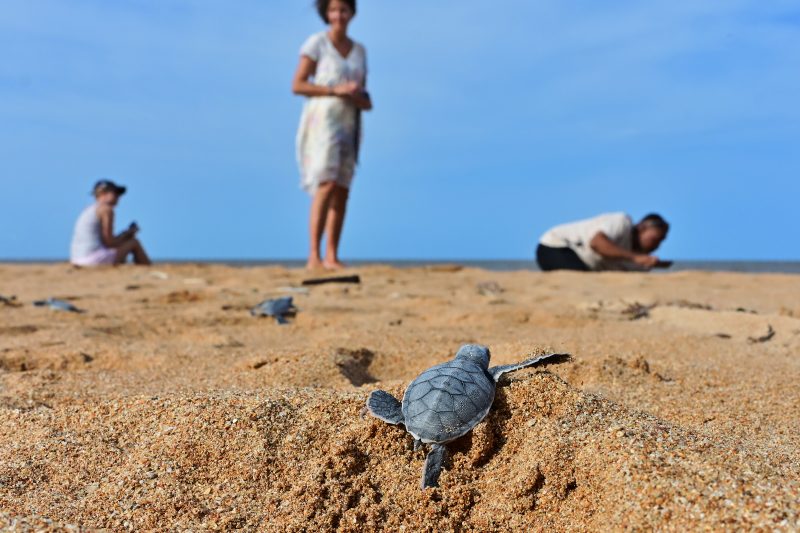Planned coal plant blackens the mood in Kenya’s idyllic Lamu
Locals fear a planned coal-fired plant threatens the pristine beauty of Kenya’s Lamu archipelago, home to five species of threatened turtles (TONY KARUMBA)
Lamu (Kenya) (AFP) – In the Lamu archipelago, fishermen ply the channels between lush mangrove forests while life in an ancient Swahili town idles at the pace of the donkeys and boats which are the main means of transport.
Life has changed little over the centuries in this part of Kenya’s north coast, however residents fear their pristine environment will soon be blighted by a coal-fired power station spewing noxious gases.
“I think it is going to be terrible, it is going to destroy a lot of the environment here,” says Thabit Omar Mohamed, 29, as he unwinds his fishing line from a block of wood, skewers a piece of shrimp on the hook, and tosses it into the water.
“We believe so many people are going to have problems with their health like cancer, disease,” he said.
Kenya’s government is planning to build a 981 megawatt coal plant in Kwasasi, about 20 kilometres (13 miles) from Lamu town, a UNESCO world heritage site that is the oldest Swahili settlement in Africa.
However construction has been stalled for years due to resistance from locals, and the National Environmental Tribunal will on Monday rule on the fate of the project, with activists contesting the conduct of an environmental impact assessment.
The natural beauty of the archipelago includes wide, endless beaches and waters rich in coral and marine life including five species of threatened turtles.
Tourism and fishing are the main sources of income, and the former is only now recovering eight years after a British couple was kidnapped on an island north of Lamu.
If the coal plant is built, tourists “won’t come to Lamu. It will be like a few years back,” bemoans Mohamed’s uncle Ali Sultan, who is out fishing with him.
When not fishing, Sultan is a tour guide, and the small boat they are on, named “Lamu Uber”, is also used to ferry tourists up and down the island.
– Heritage in danger –
The Kenyan government argues that the power plant is essential to drive economic growth, pointing to the use of coal by “highly developed” countries.
However critics are baffled by a decision to turn to coal at a time when much of the world is doing the opposite and investing in increasingly cheaper renewable energies.
Especially as Kenya already leads in this regard, with most of its energy currently coming from hydropower, geothermal and wind sources. The country also committed to reduce greenhouse gas emissions by 30 percent under the Paris Agreement.
“We want development in Lamu but a coal power plant is not what we are asking for,” said Khadija Shekuwe Famau of Save Lamu, a community group contesting the plant’s construction.
Research by Greenpeace has shown the plant will increase air pollution and lead to acid rain, while a cooling system which pumps warmed water back into the ocean could kill off marine life and coral reefs.
UNESCO last week called for a halt to the plant’s development ahead of its meeting in Azerbaijan in July, raising the possibility of the site being added to the list of World Heritage in Danger in 2020.
– ‘Costly error’ –
The bulk of the $2 billion project is being financed by China and it will be developed by Amu Power, a joint venture between a Kenyan firm and Oman’s Gulf Energy. Construction will be carried out by China Power Global.
The coal plant is part of a mega-project which includes the construction of a port in Lamu, as well as highways and oil pipelines linked to landlocked South Sudan and Ethiopia.
The ambitious project is called Lamu Port, South Sudan, Ethiopia Transport Corridor (LAPSSET), and construction is well underway, with one of the first berths of the port nearly completed.
The project has already had a severe impact on the environment, say Sultan and Mohamed, with dredging covering a key coral reef with silt and devastating a popular fishing spot.
In 2018 a court ordered the government to pay more than 4,500 fishermen compensation of $18 million, a decision now under appeal.
Last week, a report by the US-based Institute for Energy Economics and Financial Analysis warned that electricity from the plant may cost consumers 10 times more than projected.
The report said the plant would be a “costly error” for the country, with the 25-year contract requiring a capacity payment of $360 million annually even if no power is generated at the plant.
It says that Kenya’s energy demand growth has been much lower than estimated, due to lower than expected economic growth.
The government’s own 2017-2037 power development plan warns that if moderate growth continues as it has, the plant will be “grossly underutilised”.
However Amu Power’s chief operating officer Cyrus Kirima denies these concerns, insisting the electricity generated will be a fixed 7.8 US cents per kilowatt.
He added that the coal plant would use the latest technology, which reduces emissions, and will also desalinate water for consumption on the water-scarce islands.
“I think there is no point of getting scared by the coal plant, technology has evolved,” he told AFP.
But most residents are not convinced.
“LAPSSET, it has a lot of impact, but at least it is understandable. For the coal, there is no way you can understand it,” said Famau.
Disclaimer: Validity of the above story is for 7 Days from original date of publishing. Source: AFP.


